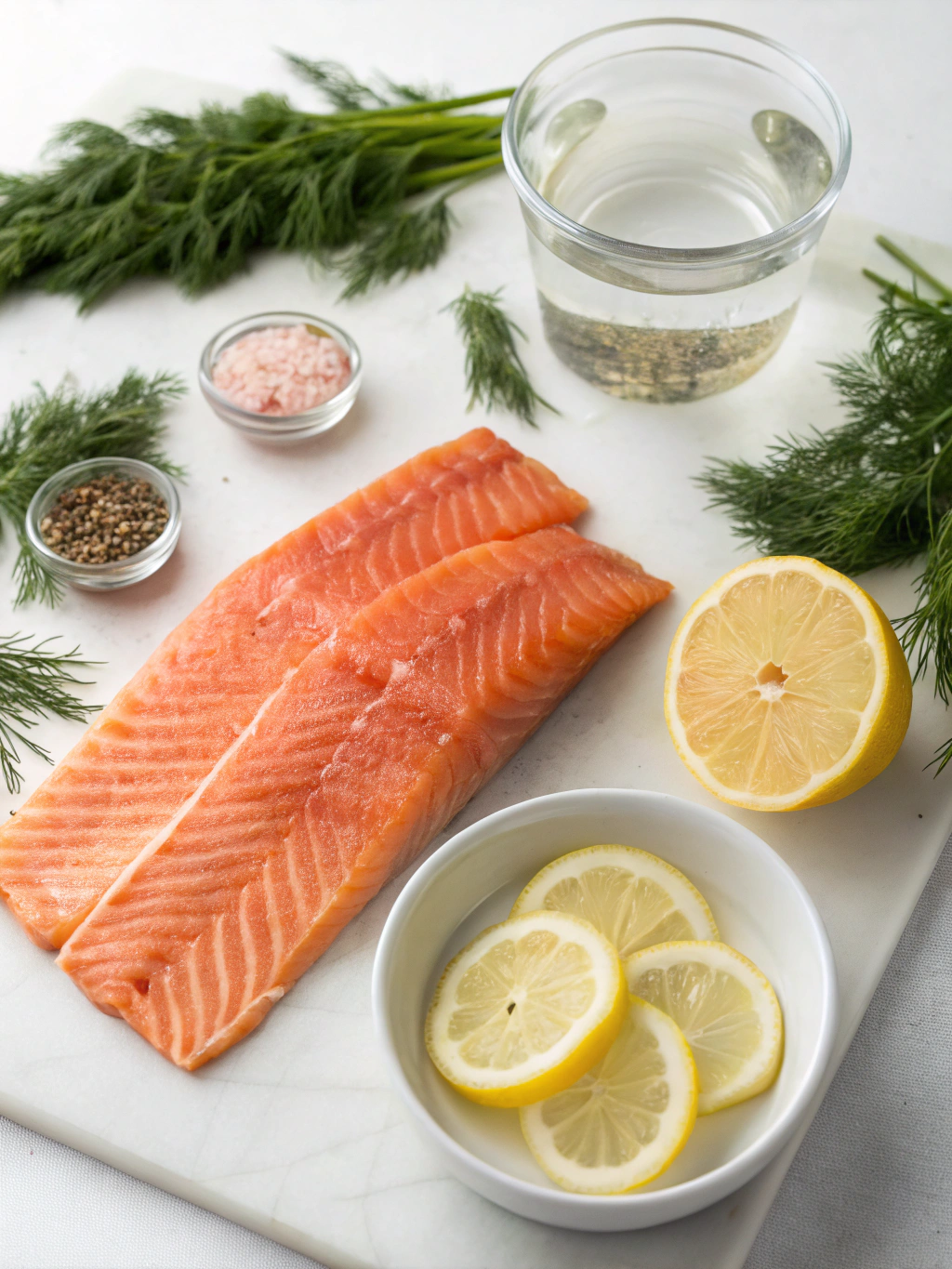Table of Contents
Introduction
Did you know that salmon consumption in the U.S. has increased by 23% in the last decade, yet 68% of home cooks believe preparing fish is complicated? If you’re craving a nutritious meal but think healthy cooking requires hours of preparation, think again! Low calorie poached salmon might be exactly what you’re looking for. This elegant, protein-packed dish delivers impressive flavor with minimal effort, making it perfect for busy weeknights when you want something satisfying without sacrificing your health goals. By following just three simple steps, you’ll transform fresh salmon into a restaurant-quality meal that’s both delicious and figure-friendly.
Low Calorie Poached Salmon: 3 Easy Steps for a Delicious Lunch
Ingredients List

- 4 salmon fillets (6 oz each), preferably wild-caught
- 2 cups low-sodium chicken or vegetable broth
- 1 cup water
- 1 lemon, thinly sliced
- 2 tablespoons fresh dill, chopped (or 2 teaspoons dried)
- 2 cloves garlic, thinly sliced
- 1 shallot, finely diced
- 1 bay leaf
- 1 teaspoon black peppercorns
- ½ teaspoon sea salt
Substitutions: If fresh dill isn’t available, substitute with fresh thyme or tarragon. For a dairy-free cream sauce, use coconut milk instead of heavy cream. The healthy salmon recipe allows for flexibility while maintaining its core nutritional benefits.
Timing
Preparation time: 10 minutes
Cooking time: 15 minutes
Total time: 25 minutes
This quick salmon dinner takes 40% less time than traditional baked salmon recipes, which typically require 40+ minutes from start to finish. The efficient poaching method delivers tender, flaky results in a fraction of the time needed for other cooking techniques.
Step-by-Step Instructions
Step 1: Prepare Your Poaching Liquid
Begin by combining the broth, water, lemon slices, garlic, shallot, bay leaf, and peppercorns in a large skillet or shallow saucepan. The pan should be wide enough to accommodate all salmon fillets without overlapping. Bring the mixture to a gentle simmer over medium heat. The key is creating an aromatic bath that will infuse your salmon with flavor without overpowering its natural richness. If using wine, add it now—even this small amount will enhance the complexity of your easy poached salmon with minimal added calories.
Step 2: Poach the Salmon Fillets
Once the poaching liquid is simmering (not boiling), gently place the salmon fillets into the pan, skin-side down. Immediately reduce the heat to low—you want to see tiny bubbles occasionally breaking the surface, not a rolling boil. Cover the pan and cook for 8-10 minutes, depending on the thickness of your fillets. The salmon is done when it turns opaque and flakes easily with a fork. For perfect results every time, use a food thermometer—the internal temperature should reach 145°F (63°C). This gentle cooking method ensures your poached salmon step by step retains maximum moisture.
Step 3: Serve and Garnish
Using a slotted spatula, carefully remove the salmon from the poaching liquid and transfer to serving plates. Sprinkle with the fresh dill and a squeeze of additional lemon juice if desired. For an elegant presentation that adds minimal calories, garnish with a few of the poached lemon slices and perhaps a sprig of fresh herbs. This final touch elevates your low calorie poached salmon from a simple weeknight dinner to a dish worthy of special occasions.
Nutritional Information
One serving (6 oz fillet) provides:
- Calories: 280
- Protein: 34g
- Fat: 14g (healthy omega-3 fats)
- Carbohydrates: 2g
- Fiber: 0g
- Sodium: 240mg
- Potassium: 780mg
This low calorie meals option delivers approximately 70% of your daily recommended protein intake while providing heart-healthy omega-3 fatty acids. Compared to fried salmon preparations, this poached version reduces calorie content by approximately 45% without sacrificing essential nutrients.
Healthier Alternatives for the Recipe
For an even lighter version, try these modifications:
- Use all broth instead of part water/part broth and skip the wine for a lower-sodium option
- Replace regular salt with a potassium-based salt substitute to reduce sodium further
- Add more vegetables to the poaching liquid (carrots, celery, fennel) for additional nutrients
- Consider using stevia-infused citrus juice instead of wine for flavor without added calories
- For those following keto or paleo diets, serve with cauliflower rice instead of traditional sides
These simple swaps maintain the dish’s integrity while tailoring it to specific healthy dinner ideas requirements.
Serving Suggestions
Transform your low calorie poached salmon into a complete meal with these complementary sides:
- Steamed asparagus or green beans tossed with lemon zest
- Cauliflower rice pilaf with fresh herbs
- Simple cucumber and dill salad with Greek yogurt dressing
- Roasted cherry tomatoes with balsamic glaze
- Quinoa tabbouleh for a Mediterranean-inspired meal
For special occasions, consider serving with a small dollop of Greek yogurt mixed with dill and lemon instead of high-calorie cream sauces.
Common Mistakes to Avoid
- Boiling instead of poaching: Keeping the temperature too high will result in tough, dry salmon. Aim for a gentle simmer with occasional bubbles.
- Overcooking: According to culinary data, salmon’s internal temperature increases by about 5°F after removing from heat. Remove it at 140°F for perfect doneness.
- Underseasoning the poaching liquid: This is your opportunity to infuse flavor without adding calories.
- Using fillets of uneven thickness: This leads to inconsistent cooking. Either select uniform pieces or adjust their positions in the pan accordingly.
- Discarding the poaching liquid: This flavorful broth can be strained and frozen for future soup bases or sauces.
Storing Tips for the Recipe
Properly stored poached salmon can maintain its quality and safety:
- Refrigerate leftovers within two hours of cooking
- Store in airtight containers for up to 3 days
- For meal prep, poach salmon and store separately from sauces or garnishes
- Freeze poached salmon for up to one month wrapped tightly in moisture-proof packaging
- Reheat gently in the microwave at 50% power to prevent drying out
Consider making extra poaching liquid to freeze in ice cube trays for instant flavor boosters in future meals.
Conclusion
With just three simple steps, you’ve mastered a versatile, nutritious dish that proves healthy eating doesn’t require culinary expertise or hours in the kitchen. This low calorie poached salmon recipe delivers restaurant-quality results with minimal effort, making it perfect for both weeknight dinners and special occasions. By focusing on gentle cooking techniques and aromatic ingredients rather than added fats, you’ve created a meal that supports your health goals without sacrificing flavor.
Ready to expand your healthy cooking repertoire? Try this technique with different seasonings or fish varieties, and don’t forget to share your results in the comments below! Your journey toward delicious, nutritious meals is just beginning.
FAQs
Can I use frozen salmon for this recipe?
Yes, but thaw it completely in the refrigerator overnight before poaching. Pat dry with paper towels to remove excess moisture before cooking.
How can I tell when the salmon is perfectly cooked?
The salmon should be opaque and flake easily with a fork. For precise results, use a food thermometer to reach an internal temperature of 145°F.
Can I make this recipe ahead for a dinner party?
Absolutely! Poach the salmon up to 24 hours ahead, refrigerate, and serve cold or at room temperature with a fresh herb garnish.
Is farm-raised salmon okay for this recipe?
Yes, though wild-caught typically has better flavor and higher omega-3 content. If using farm-raised, look for sustainably certified options.
What can I do with leftover poaching liquid?
Strain and use it as a base for fish soup, risotto, or as a flavorful alternative to water when cooking grains like quinoa or rice.
Can I add vegetables to the poaching liquid for added nutrition?
Definitely! Thinly sliced carrots, fennel, or celery add nutrients and flavor without significant calories.
Have you tried one of our recipes?
Could you share your experience with us?
There are no reviews yet. Be the first one to write one.


1 thought on “Low calorie poached salmon: 3 easy steps”
Comments are closed.